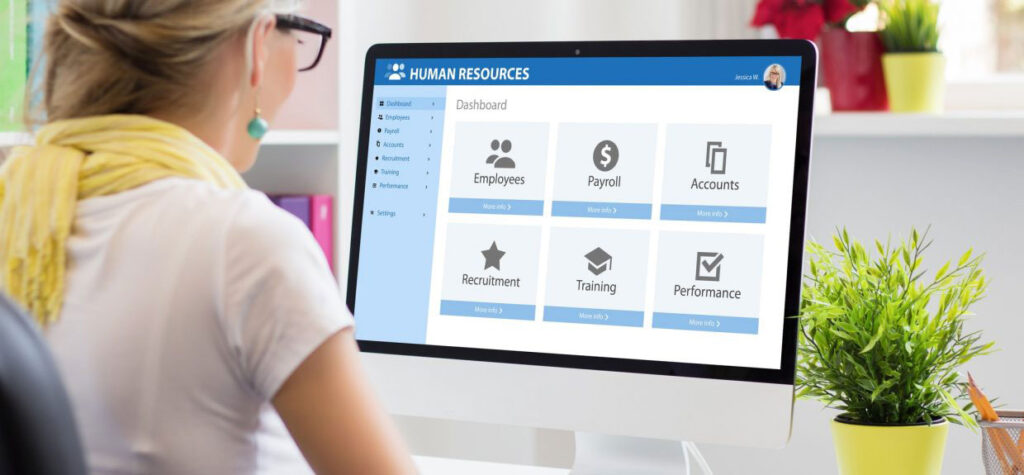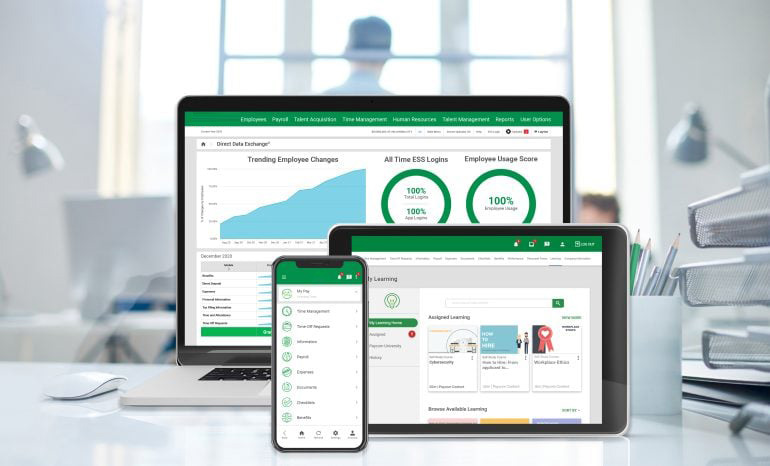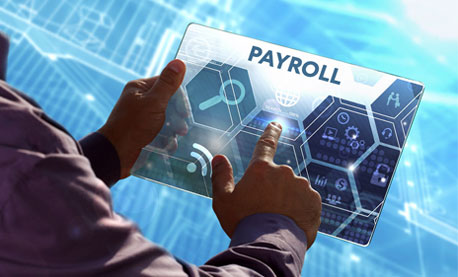HR and Payroll Software: Streamlining Human Resources and Payroll Processes
HR and Payroll software refers to a specialized software solution designed to streamline and automate various human resources and payroll functions within an organization. It provides a centralized platform that integrates multiple HR and payroll processes, eliminating the need for manual paperwork and reducing the chances of errors. With HR and Payroll software, organizations can efficiently manage employee data, attendance tracking, benefits administration, timekeeping, payroll processing, and compliance reporting.

Benefits of Implementing HR and Payroll Software
Implementing HR and Payroll software offers numerous benefits for organizations of all sizes. Here are some key advantages:
- Streamlined Processes: HR and Payroll software automates repetitive and time-consuming tasks, such as data entry, attendance tracking, and payroll calculations. This streamlines processes, improves efficiency, and reduces the likelihood of errors.
- Cost Savings: By automating HR and payroll functions, organizations can save costs associated with manual paperwork, printing, and storage. Additionally, software solutions often offer comprehensive reporting capabilities, enabling organizations to identify cost-saving opportunities and make data-driven decisions.
- Improved Accuracy: Manual HR and payroll processes are prone to errors, which can lead to compliance issues and dissatisfied employees. HR and Payroll software minimizes human error by automating calculations and ensuring accurate data entry.
- Enhanced Compliance: Staying compliant with labor laws and regulations is crucial for organizations. HR and Payroll software simplifies compliance reporting by generating accurate reports and ensuring adherence to legal requirements.
- Data Accessibility: With HR and Payroll software, authorized personnel can access employee data, attendance records, and payroll information in real-time. This improves data accessibility and enables quick decision-making.
- Employee Self-Service: Many HR and Payroll software solutions provide employee self-service portals, empowering employees to access and update their personal information, view pay stubs, and request time off. This reduces administrative burden and improves employee satisfaction.
Key Features to Look for in HR and Payroll Software
When selecting HR and Payroll software for your organization, it’s important to consider the following key features:
- Employee Database Management: A robust HR and Payroll software should have a centralized employee database that stores essential employee information, including personal details, contact information, employment history, and performance records.
- Attendance Tracking: The software should offer efficient attendance tracking mechanisms, such as biometric integration or timesheet management, to accurately record employee attendance and enable easy tracking.
- Payroll Processing: Look for software that offers comprehensive payroll processing capabilities, including automatic tax calculations, direct deposit management, and customizable pay structures.
- Benefits Administration: An ideal HR and Payroll software should have features for managing employee benefits, such as healthcare plans, retirement contributions, and leave accruals.
- Time and Leave Management: The software should provide functionalities for tracking employee hours worked, managing time-off requests, and ensuring compliance with labor laws and company policies.
- Reporting and Analytics: Look for software that offers robust reporting and analytics capabilities, allowing you to generate various HR and payroll reports, monitor key performance indicators, and gain valuable insights into your workforce.
- Integration Capabilities: Consider software that seamlessly integrates with other systems, such as accounting software or time and attendance systems, to eliminate duplicate data entry and ensure data accuracy.

Choosing the Right HR and Payroll Software for Your Organization
Selecting the right HR and Payroll software for your organization requires careful consideration of your specific needs and requirements. Here are some factors to keep in mind during the selection process:
- Scalability: Ensure that the software can accommodate your organization’s current and future needs as it grows. Scalable solutions allow for easy expansion and can adapt to changing business requirements.
- User-Friendliness: Look for software with an intuitive user interface and easy navigation. User-friendly software reduces the learning curve and ensures efficient adoption by your HR team.
- Customization Options: Consider software that offers customization options to align with your organization’s unique HR and payroll processes. This allows you to tailor the software to fit your specific requirements.
- Vendor Support and Reputation: Research the vendor’s reputation in the market and their customer support offerings. Opt for a vendor known for excellent support and reliable software updates.
- Data Security: Prioritize software solutions that prioritize data security and compliance with industry standards. Look for features like data encryption, access controls, and regular backups.
Integration Capabilities of HR and Payroll Software
Integration capabilities are a crucial aspect to consider when selecting HR and Payroll software. Integration enables seamless data flow between different systems, eliminating the need for manual data entry and reducing the chances of errors. Here are some common integration points for HR and Payroll software:
- Accounting Software: Integrating HR and Payroll software with accounting software ensures accurate financial reporting by synchronizing payroll data with general ledger accounts.
- Time and Attendance Systems: Integration with time and attendance systems allows for automatic data transfer, streamlining the process of tracking employee hours worked and calculating payroll.
- Benefits Administration Platforms: Integrating HR and Payroll software with benefits administration platforms ensures accurate and up-to-date employee benefit information for seamless benefits management.
- Recruitment and Applicant Tracking Systems: Integration with recruitment and applicant tracking systems enables a smooth transition from candidate selection to employee onboarding, ensuring accurate data transfer and reducing administrative overhead.
Common Challenges in Implementing HR and Payroll Software
Implementing HR and Payroll software can come with its own set of challenges. Organizations should be aware of these challenges to ensure a successful implementation. Some common challenges include:
- Resistance to Change: Employees may resist adopting new software, especially if they are accustomed to manual processes. Proper training and change management strategies are essential to overcome resistance and facilitate smooth adoption.
- Data Migration: Migrating data from existing systems to the new HR and Payroll software can be complex. Careful planning, data cleansing, and validation are crucial to ensure accurate data migration.
- Integration Complexities: Integrating the new software with existing systems may present technical challenges. Involving IT professionals and working closely with software vendors can help overcome integration complexities.
- Data Security Concerns: Organizations must address data security concerns and ensure that the software vendor adheres to industry-standard security practices. This includes data encryption, access controls, and regular security audits.
- Ongoing Maintenance and Support: Once the software is implemented, organizations need to allocate resources for ongoing maintenance, updates, and support. Regular software updates and vendor support are crucial for uninterrupted operations.
How HR and Payroll Software Enhances Employee Self-Service
HR and Payroll software often includes self-service portals that empower employees to access and manage their own HR and payroll information. Here’s how HR and Payroll software enhances employee self-service:

- Personal Information Management: Employees can update their personal details, contact information, and emergency contacts through the self-service portal, eliminating the need for manual paperwork and reducing administrative burden.
- Leave Management: Employees can request time off, view their leave balances, and track the status of their leave requests through the self-service portal. This provides transparency and streamlines the leave management process.
- Payroll Information: Self-service portals allow employees to view their pay stubs, download W-2 forms, and access information related to their salary, deductions, and benefits. This promotes transparency and empowers employees to manage their finances.
- Training and Development: HR and Payroll software can provide access to training resources, employee handbooks, and professional development opportunities through the self-service portal. This encourages employee growth and engagement.
Mobile Accessibility and HR and Payroll Software
With the increasing use of mobile devices, it’s essential for HR and Payroll software to offer mobile accessibility. Mobile accessibility allows employees and HR professionals to access HR and payroll information on the go. Mobile apps or responsive web interfaces provide the following benefits:
- Remote Access: Employees can access their HR and payroll information anytime, anywhere, using their mobile devices. This flexibility improves employee satisfaction and productivity.
- Real-Time Notifications: Mobile apps can send push notifications for important updates, such as payslip availability, leave approvals, or upcoming deadlines. This ensures timely communication and keeps employees informed.
- Convenience: Mobile accessibility allows employees to perform various HR-related tasks, such as submitting time-off requests or updating personal information, conveniently from their smartphones. This saves time and enhances user experience.
- Managerial Approvals: Managers can review and approve employee requests, such as leave requests or timesheets, through mobile apps. This streamlines the approval process and improves workflow efficiency.
Ensuring Data Security with HR and Payroll Software
Data security is of paramount importance when it comes to HR and Payroll software. Organizations need to take proactive measures to ensure the security of sensitive employee data. Here are some key considerations for ensuring data security:
- Data Encryption: HR and Payroll software should use encryption algorithms to protect data during transmission and storage. This prevents unauthorized access and safeguards sensitive information.
- Access Controls: Implement strict access controls to limit data access only to authorized personnel. User roles and permissions should be defined to restrict access based on job roles and responsibilities.
- Regular Data Backups: Regularly backup HR and payroll data to prevent data loss in case of system failures, natural disasters, or security breaches. Backups should be stored securely and tested for data restoration.
- Employee Data Privacy: Ensure compliance with data privacy regulations, such as GDPR or CCPA. Obtain employee consent for data collection and processing and clearly communicate your organization’s data privacy policies.
- Security Audits: Conduct regular security audits to identify vulnerabilities and address them promptly. Engage third-party security experts to perform penetration testing and vulnerability assessments.
The Future of HR and Payroll Software
As technology continues to advance, the future of HR and Payroll software holds exciting possibilities. Here are some trends that may shape the future of HR and Payroll software:
- Artificial Intelligence (AI) and Machine Learning (ML): AI and ML technologies can automate complex HR and payroll tasks, such as resume screening, employee sentiment analysis, and predictive analytics for workforce planning.
- Chatbots and Virtual Assistants: Chatbots and virtual assistants can provide instant responses to employee queries related to HR and payroll, improving user experience and reducing the burden on HR teams.

- Blockchain Technology: Blockchain technology has the potential to enhance data security and integrity in HR and Payroll processes. It can ensure tamper-proof records, streamline verification processes, and enable secure sharing of employee credentials.
- Data Analytics and Predictive Insights: Advanced analytics capabilities will enable organizations to gain deeper insights into their workforce data. Predictive analytics can help in talent acquisition, retention strategies, and identifying potential compliance risks.
- Integration with Cloud-Based Services: Integration with cloud-based services will allow for seamless data exchange between different HR and payroll systems, providing a unified and scalable solution.
Frequently Asked Questions (FAQs)
Q: What is HR and Payroll software? A: HR and Payroll software is a specialized software solution that automates and streamlines various human resources and payroll functions within an organization. It helps in managing employee data, attendance tracking, benefits administration, payroll processing, and compliance reporting.
Q: What are the benefits of implementing HR and Payroll software? A: Implementing HR and Payroll software offers benefits such as streamlined processes, cost savings, improved accuracy, enhanced compliance, data accessibility, and employee self-service capabilities.
Q: What key features should I look for in HR and Payroll software? A: Key features to consider include employee database management, attendance tracking, payroll processing, benefits administration, time and leave management, reporting and analytics, and integration capabilities.
Q: How do I choose the right HR and Payroll software for my organization? A: Consider factors such as scalability, user-friendliness, customization options, vendor support and reputation, and data security when selecting HR and Payroll software.
Q: What are the common challenges in implementing HR and Payroll software? A: Common challenges include resistance to change, data migration complexities, integration challenges, data security concerns, and ongoing maintenance and support requirements.
Q: How does HR and Payroll software enhance employee self-service? A: HR and Payroll software with self-service portals allows employees to update personal information, manage leave requests, access payroll information, and participate in training and development programs.
Conclusion
HR and Payroll software revolutionizes the way organizations manage their human resources and payroll processes. With streamlined automation, improved accuracy, and enhanced data accessibility, organizations can optimize their HR operations and ensure compliance with legal requirements. By considering key features, integration capabilities, and data security, organizations can choose the right software solution that meets their specific needs. Embracing the advancements in mobile accessibility, AI, and data analytics will shape the future of HR and Payroll software, empowering organizations to make data-driven decisions and enhance employee experiences. GCTL INFOSYS Provide Custom HR and Payroll software for any types of Organizations.



